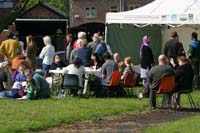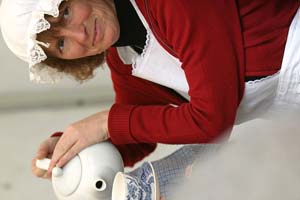Devon Gardens
 A tea party in the park, organised by Burngreave Voices and Burngreave Green Environment Programme in 2005 © Carl Rose  An Irish Piper (Francis Feeley in costume) at the tea party © Carl Rose  Nikky Wilson pouring tea at the tea party © Carl Rose Over the years the Devon Gardens' fortunes have fluctuated. Even in 1928 there were complaints to the corporation that it the park wasn't being maintained. It is largely as a result of this neglect and the subsequent community action that the character of the park has been preserved. A shortage of funding in the 1960s and '70s meant that the park was poorly maintained. In the 1980s proposals were drawn up to provide new paths. However local residents protested at the lack of consultation and demanded that the original features and layout of the park were kept. As a result the essential character of the park was saved from destruction. |
